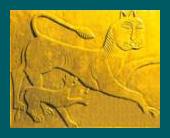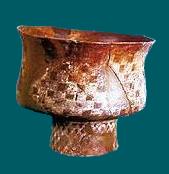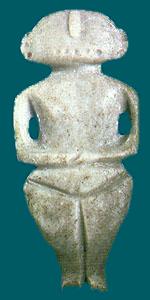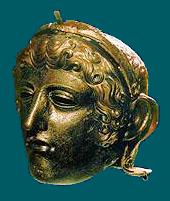
Relief of Lioness with a cub. Stara Zagora, XI-XII c.
Temple of Apollon and Temple of Artemis. Bronze coins minted in Augusta Trayana. III c. Reverse

History of Stara Zagora

Vessel, earthen, decorated with dark and light squares "Calendar". Early Neolith - 6000 BC. |

Marble human figure. Village mound in the region of Stara Zagora spa. Late Chalcholith - 4000 BC. |

Helmet - mask, bronze. Mound necropolis in the region of villa-rustic Tchatalka, Stara Zagora district - 1 c. |
Georgi Danchov (1846-1908). St. Ivan Rilski with life scenes. Icon from 1863. Distemper, wood, 128/82 cm. |
Stara Zagora, located in the southern part of Bulgaria, is one of the largest cities in the country with a population of 200 000. Situated at the foot of the Sredna Gora Mountains, to the East and the South, Stara Zagora is 197 m above sea level. The city enjoys a year around temperate climate with mild, short winters due to the strong influence of the Mediterranean in the Maritza River Valley. The average temperature is 13 degrees C. Strategically located, it is a central hub with international transportation routes providing easy access to the North, East, South and West. The region enjoys a productive agricultural sector due to extremely fertile land. These positive elements are indications why life has existed in the Stara Zagora region since prehistoric times.
At the end of the 7th and the beginning of the 6th millenium (The New Stone Age), the first inhabitants came to this area making their living from agriculture and cattle breeding. Their dwellings were called settlement mounds existing for 2 to 3 millenia. There are five prehistoric settlements within the area of Stara Zagora. One of the five prehistoric settlements, Bereketska Mound – 17 m tall with a diameter at the foundation of 250 m, is considered the largest in Bulgaria.
Extensive archaeological research had resulted in the preservation of the two Neolithic dwellings (6th millenium BC) in Stara Zagora. They contain the inner furnishings and implements and are considered the best preserved from the epoch in Europe.
Seven km North-West of town is Metchi Kladenets lay. This is the area where the prehistoric man living in our lands found the first metal (copper) in the most ancient copper mines in Europe at the end of the 5th millennium BC. Copper was mined in open galleries and copper articles were produced and traded on a large scale reaching even the Volga River, now in Russia.
Settlement life continued in the region during Thracian Antiquity. During the 4th century BC, a significant ancient Thracian Settlement known as Beroe existed. After 107 AD, not far from Beroe, Emperor Mark U. Trayan (98 - 117) founded the town of Ulpia Augusta Trayana thought to be second in significance after Philippopol in the province of Thrace. Located on 50 ha, it was fortified with a massive fortress wall and enjoyed significant autonomy from its municipal centre. A town council (Boule) and Demos governed the town affairs. The town minted its own coins from the middle of the 2nd century to the middle of the 3rd century AD.
The excavations of the ancient town revealed a forum, necropolis, streets, public and private buildings, colour-floor mosaics and others.
Beroe (Vereya) had been considerably ravaged as a result of the Gothic, the Huns, the Avarian and the Slavonic invasions.
After the founding of the Bulgarian State, Beroe began to grow and establish its reputation as a strategic military administrative centre. With a border area location, Beroe served the political interests of Bulgaria and Byzantium. The significance of the town was apparent when Empress Irina visited the town helping to rebuild the fortress walls. Beroe was then named after her as Irinoppolis.
After 812 the town was conquered by Khan Krum and was included within the Bulgarian State borders and the old name of Beroe was restored.
The crusade of Emperor Yoan Tsimisshii in 969 against Bulgaria resulted in Beroe again being conquered by the Byzantines.
Beroe became an emperor’s residence under the rule of the Komniniti Dynasty.
The most significant archaeological monuments from the Middle Ages of the town date back to the period of 11th through 12th century, with the stand-out five stone effigies of animals.
Beroe continued to have the status of a regional administrative centre within the borders of the Bulgarian State until the rule of Tsar Ivan Assen.
The town began a gradual decline after the middle of the 13th century.
The town was an insignificant half-destroyed fortress when conquered by the Turks in 1364 when they gave it a new name, Eski Hisar and then later changed it to Eski Zagressi Hisar – Eski Zagra that was used as the official name until 1871.
During the National Revival period (18th through 19th century) the town became an important economic centre with over 70 workshops producing 50 different craft items. Later the first factories were established. By 1858, Stara Zagora had five schools for boys and three for girls and a cultural centre was established. Late in the 1850s the town was given the name Zheleznick and in 1871 the present-day name of Stara Zagora was officially adopted and the Stara Zagora diocese was founded.
During the War of Liberation on July 31, 1877, the first major clash between the two fighting forces, Turkey and Russia, took place near Stara Zagora. As a result the town was completely destroyed by fire and 14 500 defenceless citizens died.
The first symbolic foundation stone was laid on October 5th, 1879 and the restoration of Stara Zagora began. The plan drafted by Lyubor Bayer was followed which turned Stara Zagora into the first modern Bulgarian town after the Liberation.
The region experienced an economic upsurge. The first opera and theatre in the province were opened resulting in an expansion of musical and theatrical life. The town has become famous for its lime-trees, painters and poets.
Today Stara Zagora is a modern and dynamic city with a well-developed economy that includes machine-building, food-processing, wine, brewing and cigarette industries. The city is an educational centre with many specialized secondary schools as well as scientific and cultural institutes and Trakia University’s Medical Faculty, Veterinary Medicine Faculty, Agrocultural Faculty, Pedagogy Faculty, five colleges and University Hospital.
During its thousand year history, Stara Zagora has risen from the ashes many times, has suffered and come to life again after the numerous vicissitudes but it has always remained a centre of economic, political and cultural life and is one of the most modern contemporary cities in Bulgaria.
Petar Kalchev
Director of the Historical Museum, Stara Zagora